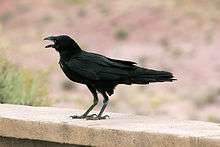Chihuahuan raven
| Chihuahuan raven | |
|---|---|
 | |
| Chihuahuan raven in Arizona | |
| Scientific classification | |
| Kingdom: | Animalia |
| Phylum: | Chordata |
| Class: | Aves |
| Order: | Passeriformes |
| Family: | Corvidae |
| Genus: | Corvus |
| Species: | C. cryptoleucus |
| Binomial name | |
| Corvus cryptoleucus Couch, 1854 | |
 | |
| Distribution map | |
The Chihuahuan raven (Corvus cryptoleucus) is a species of bird in the family Corvidae that is native to the United States and Mexico. It was formerly known as the American white-necked raven, and has the proportions of a common raven with a heavy bill, but is about the same size as a carrion crow, or slightly larger than the American crow (44–51 cm (17–20 in) long). The plumage is all-black with a rich purple-blue gloss in good light. Like the forest raven, little raven, fan-tailed raven and Australian raven, it is one of the smaller raven species. The larger species of raven are the common raven, thick-billed raven, white-necked raven and brown-necked raven, with the common and thick-billed ravens being the world's largest raven species and the little and fan-tailed ravens being the smallest. The Chihuahuan raven is very similar in appearance to the Australian raven, although with dark brown irises and whiter feather bases. The nasal bristles extend farther down the top of the bill than in any other Corvus species to about two-thirds the length. The base of the neck feathers are white-ish (seen only when ruffled in strong wind). The bill, legs and feet are black.
Distribution and habitat
The Chihuahuan raven occurs in the Southwestern and Midwestern United States and northern Mexico, including southeastern Arizona, southern New Mexico, southeastern Colorado, western Kansas, western Oklahoma, and southern and western Texas.[2]
Behavior
Diet
It feeds on cultivated cereal grains, insects and many other invertebrates, small reptiles, carrion and scraps of human food, cactus fruits, eggs and nestlings.
Nesting
The nest is built in either trees, large shrubs or sometimes even in old buildings. There are usually 5–7 eggs laid relatively late in the year during May so as to take advantage of the insect food for their young in their more arid environment.
Voice
The voice is similar to that of the common raven with "pruk-pruk" sounds and other croaks but is not as deep in tone. Like all corvids, the Chihuahuan raven is capable of vocal mimicry, however this behavior is mostly recorded in captivity and, although rarely, in the wild.
Taxonomy
A 2005 molecular study reviewed segments of DNA of the common raven and found that Chihuahuan raven are genetically nested within common ravens based on mitochondrial DNA. That is, common ravens from the California clade are more similar in mtDNA to Chihuahuan ravens than they are to common ravens in the Holarctic Clade.[3][4]
References
- ↑ BirdLife International (2012). "Corvus cryptoleucus". IUCN Red List of Threatened Species. Version 2013.2. International Union for Conservation of Nature. Retrieved 26 November 2013.
- ↑ "Chihuahuan Raven, Life History". All About Birds. Cornell Laboratory of Ornithology. Retrieved 2009-08-10.
- ↑ Feldman, C. R.; Omland, K. E. (2005). "Phylogenetics of the common raven complex (Corvus: Corvidae) and the utility of ND4, COI and intron 7 of the β-fibrinogen gene in avian molecular systematics". Zoologica Scripta. 34 (2): 145. doi:10.1111/j.1463-6409.2005.00182.x.
- ↑ Omland, K. E.; Tarr, C. L.; Boarman, W. I.; Marzluff, J. M.; Fleischer, R. C. (2000). "Cryptic genetic variation and paraphyly in ravens" (PDF). Proceedings of the Royal Society B: Biological Sciences. 267 (1461): 2475–82. doi:10.1098/rspb.2000.1308. PMC 1690844
 . PMID 11197122.
. PMID 11197122.
External links
- Photo of Chihuahuan Raven
- Great shot showing white bases to neck feathers
- Comparison of Chihuahuan and Common Raven specimens
- Patuxent Bird Identification InfoCenter species account, including Breeding Bird Survey and Christmas Bird Count range maps.
- Chihuahuan Raven photo gallery VIREO
